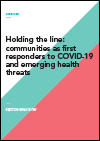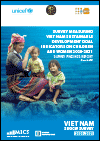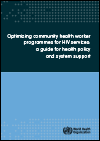What's New
Displaying results 361 - 370 of 4913

Resource | Reviews and Snapshots,
This poster illustrate the state of HIV prevention in Pakistan with detailed data on key populations, policy and structural barriers, HIV programme coverage and outcomes, HIV prevention adaptations during COVID-19, linkages between HIV and sexual and reproductive health services, antiretroviral drug-based prevention and the status of implementation of prevention 2020 roadmap.

Resource | Reviews and Snapshots,
The prevention scorecard measures and tracks prevention progress in China, including on indicators for each of the five prevention pillars as relevant to country context. Each score is based on a combination of two dimensions: outcome, and coverage.

Resource | Fact Sheets,
In December 2021, there were 993 confirmed HIV-positive individuals reported to the HIV/AIDS & ART Registry of the Philippines (HARP). Fourteen percent (143) had clinical manifestations of advanced HIV infection at the time of testing .

Resource | Publications,
In June and July 2020, UNAIDS conducted a survey of community-led organizations run by and for people living with and affected by HIV. This predominantly qualitative survey sought to gain a deeper understanding of the impact that the COVID-19 pandemic was having on the HIV-related work of community-led organizations, and to learn more about their contributions to the COVID-19 response.

Resource | Publications,
This report is based on the Survey measuring Viet Nam Sustainable Development Goal indicators on Children and Women (SDGCW) 2020-2021, the localised version of the Multiple Indicator Cluster Survey (MICS). The fieldwork was conducted from November 2020 to February 2021 by the General Statistics Office, with technical and financial assistance from UNICEF and UNFPA. The survey provides statistically sound and internationally comparable data essential for developing evidence-based policies and programmes, and for monitoring progress toward national goals and global commitments.

Resource | Publications,
UNFPA Asia and the Pacific Regional Office produced this report as an evidence review on the linkages between comprehensive sexuality education and the prevention of gender-based violence on the basis of a rapid review of existing research.

Resource | Publications,
This guide identifies interventions in prevention, testing, treatment, care, clinical management and support services for the HIV and related co-morbidities for which there is evidence that community health workers can provide safe and effective care in HIV. It also provides policy recommendations on how to design, implement and optimize CHW programmes as part of broader health workforce and service delivery strategies that are acceptable to communities and can be sustained. Finally, it outlines key knowledge gaps that should be addressed through further research.

Resource | Publications,
This framework document has been developed to help countries set up, modify and improve their data collection systems and report on their national HIV response as effectively as possible. It outlines the steps in the process of identifying sources, engaging national stakeholders, consulting on findings and reporting on them as part of GAM.

Resource | Publications,
As the capital of Indonesia, DKI Jakarta has the highest HIV prevalence in Indonesia (0,79% in 2020), and the number is four times higher than the national prevalence. It implies that HIV infection in DKI Jakarta is remains concentrated among the key population. According to national data, HIV prevalence among the men-sex-with-men group is highest compared to other groups (16%). Meanwhile, in DKI Jakarta, the highest HIV prevalence is among the IDU group (42,8%). Therefore, preventing and controlling the infection need targeted and strategic approaches. The HIV projection calculation by The AIDS Epidemic Modelling (AEM) is needed. It covers four aspects of information, which are target population, behavior and coverage program, epidemiology data, and unit cost.

Resource | Fact Sheets,
UNAIDS is leading the global effort to end AIDS as a public health threat by 2030 as part of the Sustainable Development Goals. Strong partnership among the United Nations on HIV is also helping to support the accelerated efforts in Indonesia. Advocating for the alignment of the national AIDS response to the Fast Track strategy, the Joint Team on AIDS provided support to reach key populations in Indonesia, to generate evidence to inform country programming and to integrate HIV-related services into the Universal Health Coverage (UHC) scheme.





